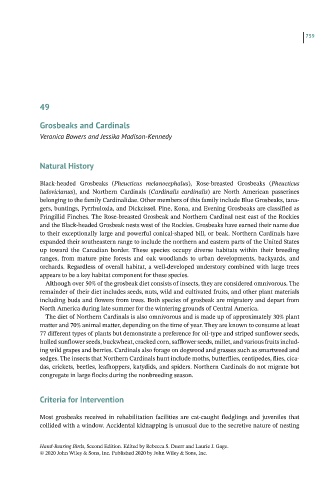Page 756 - Hand rearing birds second
P. 756
759
49
Grosbeaksand Cardinals
Veronica Bowers and Jessika Madison-Kennedy
Natural History
Black‐headed Grosbeaks (Pheucticus melanocephalus), Rose‐breasted Grosbeaks (Pheucticus
ludovicianus), and Northern Cardinals (Cardinalis cardinalis) are North American passerines
belonging to the family Cardinalidae. Other members of this family include Blue Grosbeaks, tana-
gers, buntings, Pyrrhuloxia, and Dickcissel. Pine, Kona, and Evening Grosbeaks are classified as
Fringillid Finches. The Rose‐breasted Grosbeak and Northern Cardinal nest east of the Rockies
and the Black‐headed Grosbeak nests west of the Rockies. Grosbeaks have earned their name due
to their exceptionally large and powerful conical‐shaped bill, or beak. Northern Cardinals have
expanded their southeastern range to include the northern and eastern parts of the United States
up toward the Canadian border. These species occupy diverse habitats within their breeding
ranges, from mature pine forests and oak woodlands to urban developments, backyards, and
orchards. Regardless of overall habitat, a well‐developed understory combined with large trees
appears to be a key habitat component for these species.
Although over 50% of the grosbeak diet consists of insects, they are considered omnivorous. The
remainder of their diet includes seeds, nuts, wild and cultivated fruits, and other plant materials
including buds and flowers from trees. Both species of grosbeak are migratory and depart from
North America during late summer for the wintering grounds of Central America.
The diet of Northern Cardinals is also omnivorous and is made up of approximately 30% plant
matter and 70% animal matter, depending on the time of year. They are known to consume at least
77 different types of plants but demonstrate a preference for oil‐type and striped sunflower seeds,
hulled sunflower seeds, buckwheat, cracked corn, safflower seeds, millet, and various fruits includ-
ing wild grapes and berries. Cardinals also forage on dogwood and grasses such as smartweed and
sedges. The insects that Northern Cardinals hunt include moths, butterflies, centipedes, flies, cica-
das, crickets, beetles, leafhoppers, katydids, and spiders. Northern Cardinals do not migrate but
congregate in large flocks during the nonbreeding season.
Criteriafor Intervention
Most grosbeaks received in rehabilitation facilities are cat‐caught fledglings and juveniles that
collided with a window. Accidental kidnapping is unusual due to the secretive nature of nesting
Hand-Rearing Birds, Second Edition. Edited by Rebecca S. Duerr and Laurie J. Gage.
© 2020 John Wiley & Sons, Inc. Published 2020 by John Wiley & Sons, Inc.

